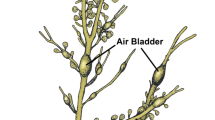Abstract
We measured the responses of pigments and chlorophyll a fluorescence parameters of the Antarctic leafy liverwort Cephaloziella varians to snowmelt during austral spring 2005 at Rothera Point on the western Antarctic Peninsula. Although no changes to the concentrations of UV-B photoprotective pigments were detected during snowmelt, chlorophyll and carotenoid concentrations and maximum photosystem (PS)II yield (F v /F m) were respectively 88, 60 and 144% higher in the tissues of the liverwort that had recently emerged from snow than in those under a 10 cm depth of snow. A laboratory experiment similarly showed that effective PSII yield increased rapidly within the first 45 min after plants sampled from under snow were removed to an illuminated growth cabinet. The pigmentation and PSII yields of plants during snowmelt were also compared with those of plants in January, during the middle of the growing season at Rothera Point. During snowmelt, plants had lower F v /F m values, chlorophyll a/b ratios and concentrations of UV-B photoprotective pigments and carotenoids than during mid-season, suggesting that although there is some recovery of PSII activity and increases in concentrations of photosynthetic pigments during snowmelt, the metabolism of C. varians is restricted during this period.




Similar content being viewed by others
References
Caldwell MM (1971) Solar UV radiation and the growth and development of higher plants. In: Giese AC (ed) Photophysiology. Academic, New York, pp 131–177
Chalker-Scott L (1999) Environmental significance of anthocyanins in plant stress responses. Photochem Photobiol 70:1–9
Cockell CS, Rettberg P, Horneck G, Wynn-Williams DD, Scherer K, Gugg-Helminger A (2002) Influence of ice and snow covers on the UV exposure of terrestrial microbial communities: dosimetric studies. J Photochem Photobiol B 68:23–32
Convey P (2001) Antarctic ecosystems. In: Levin S (ed) Encyclopedia of biodiversity. Academic, San Diego, pp 171–184
Convey P, Smith RIL (2006) Responses of terrestrial Antarctic ecosystems to climate change. Plant Ecol 182:1–10
Gould KS (2004) Nature’s Swiss army knife: the diverse protective roles of anthocyanins in leaves. J Biomed Biotech 5:314–320
Gould KS, Kuhn DN, Lee DW, Oberbauer SF (1995) Why leaves are sometimes red. Nature 378:241–242
Hamerlynck EP, Smith WK (1994) Subnivean and emergent microclimate, photosynthesis, and growth in Erythronium grandiflorium Pursh, a snowbank geophyte. Arct Alp Res 26:21–28
Kappen L (1993) Plant activity under snow and ice, with particular reference to lichens. Arctic 46:297–302
Kappen L, Breuer M (1991) Ecological and physiological investigations in continental Antarctic cryptogams II. Moisture relations and photosynthesis of lichens near Casey Station, Wilkes Land. Antarct Sci 3:273–278
Kappen L, Sommerkorn M, Schroeter B (1995) Carbon acquisition and water relations of lichens in polar regions—potentials and limitations. Lichenologist 27:531–545
Kimball SL, Bennet SD, Salisbury FB (1973) The growth and development of montane species at near freezing temperatures. Ecology 54:168–173
Lichtenthaler H, Wellburn A (1983) Determination of total carotenoids and chlorophylls a and b of leaf extracts in different solvents. Biochem Soc Trans 11:591–592
Marschall M, Proctor MCF (2004) Are bryophytes shade plants? Photosynthetic light responses and proportions of chlorophyll a, chlorophyll b and total carotenoids. Ann Bot 94:593–603
Martin CE, Churchill SP (1982) Chlorophyll concentrations and a/b ratios in mosses collected from exposed and shaded habitats in Kansas. J Bryol 12:297–304
Maxwell K, Johnson GN (2000) Chlorophyll fluorescence—a practical guide. J Exp Bot 51:659–668
Newsham KK, Hodgson DA, Murray AWA, Peat HJ, Smith RIL (2002) Response of two Antarctic bryophytes to stratospheric ozone depletion. Glob Change Biol 8:972–983
Newsham KK, Geissler PA, Nicolson MJ, Peat HJ, Lewis-Smith RI (2005) Sequential reduction of UV-B radiation in the field alters the pigmentation of an Antarctic leafy liverwort. Env Exp Bot 54:22–32
Oberbauer SF, Starr G (2002) The role of anthocyanins for photosynthesis of Alaskan arctic evergreens during snowmelt. Adv Bot Res 37:129–145
Pannewitz S, Schlensog M, Green TGA, Sancho LG, Schroeter B (2003) Are lichens active under snow in continental Antarctica? Oecologia 135:30–38
Post A (1990) Photoprotective pigment as an adaptive strategy in the Antarctic moss Ceratodon purpureus. Polar Biol 10:241–245
Post A, Vesk M (1992) Photosynthesis, pigments, and chloroplast ultrastructure of an Antarctic liverwort from sun-exposed and shaded sites. Can J Bot 70:2259–2264
Schlensog M, Pannewitz S, Green TGA, Schroeter B (2004) Metabolic recovery of continental antarctic cryptogams after winter. Polar Biol 27:399–408
Wasley J, Robinson SA, Lovelock CE, Popp M (2006) Some like it wet—biological characteristics and underpinning tolerance of extreme water stress events in Antarctic bryophytes. Funct Plant Biol 33:443–455
Acknowledgments
Funding was provided by the Natural Environment Research Council through the British Antarctic Survey’s Long Term Monitoring and Survey programme. Ozone data were supplied gratis by the NASA/GSFC TOMS Ozone Processing Team. Howard Griffiths, Sieglinde Ott, Helen Peat, Dom Hodgson, David Pearce, Paul Geissler, Matt Brown and Rod Arnold provided valuable support. Three anonymous referees kindly supplied useful comments. All are gratefully acknowledged. This study is an output of the SCAR Evolution and Biodiversity in Antarctica programme.
Author information
Authors and Affiliations
Corresponding author
Rights and permissions
About this article
Cite this article
Snell, K.R.S., Convey, P. & Newsham, K.K. Metabolic recovery of the Antarctic liverwort Cephaloziella varians during spring snowmelt. Polar Biol 30, 1115–1122 (2007). https://doi.org/10.1007/s00300-007-0269-z
Received:
Revised:
Accepted:
Published:
Issue Date:
DOI: https://doi.org/10.1007/s00300-007-0269-z




